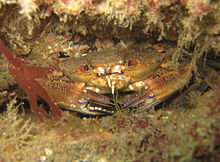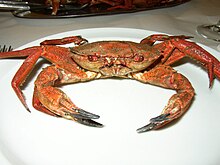Velvet crab
| Velvet crab | ||||||||||||
|---|---|---|---|---|---|---|---|---|---|---|---|---|

Velvet crab ( Necora puber ) |
||||||||||||
| Systematics | ||||||||||||
|
||||||||||||
| Scientific name of the genus | ||||||||||||
| Necora | ||||||||||||
| Holthuis , 1987 | ||||||||||||
| Scientific name of the species | ||||||||||||
| Necora puber | ||||||||||||
| ( Linnaeus , 1767) |
The velvet crab ( Necora puber ), also known as the devil's crab or woolly swimming crab, is a swimming crab of the Macropipidae family and the only species in the Necora genus . It is common in the north-east Atlantic, the North Sea and the Mediterranean. The velvet crab has striking red eyes and is valued as a food in Great Britain and Spain.
description

The carapace of velvet crabs is rather flat, the individual regions are only vaguely demarcated from one another. It is completely covered by velvety hair. The front edge between the eyes is not drawn forward, but straight to slightly concave. He has a total of 10 small teeth, of which the two outermost are more triangular and the largest. The inner teeth are smaller, more pointed, and tighter. The front edge of the carapace has five sharp teeth that are bent forward. A ridge runs from the rearmost tooth to the rear area of the carapace.
The first pair of pereiopods is rather asymmetrical and carries the large claws . The left or right pair of scissors have clearer teeth on the cutting edge, while the other one appears to be slimmer overall. However, the burrs and remaining teeth on the scissors are the same. The seven long ridges on the Chelipede dactyl are finely granulated. The tips of the scissor fingers are always black. The carpus of the Chelipeda has a raised, finely granulated surface, with a large tooth on the front edge. At the rearmost pereiopod, the dactylus is paddle-shaped, like all swimming crabs. It is sharply pointed. On both sides there are three ridges on the surface, which are also clearly visible due to the hair between them. Any ridges on periopods 2 to 5 are not granulated, but rather smooth and always surrounded by fine hairs.
Velvet crabs can be distinguished from all similar Liocarcinus or Macropipus species by the front edge of the carapace. Only velvet crabs do not have a tooth located exactly in the middle between their eyes. The granulated ridges on the dactylus of the Chelipedas in connection with the thick hairs of the carapace are characteristic.
The color appears brownish due to the hairiness. However, the carapace is greenish or bluish in color. The eyes are noticeably red. Velvet crabs are up to 10 cm wide (carapace width). Females are smaller than males at the same age because they can not molt during the incubation of the eggs that they attach to their pleopods and therefore molt less often overall.
Distribution and habitat
The velvet crab is widespread in the north-east Atlantic and in the North Sea from the coasts of southern Norway, over the British Isles to Morocco. Probably around 1900 she immigrated through the Strait of Gibraltar into the western Mediterranean. The velvet crab has only been widespread near Marseille in the Golfe du Lion since the 1970s .
Velvet crabs live at depths of up to 80 meters. The habitat is mostly rocky or stony, where the velvet crab can hide, such as rocky outcrops.
Behavior and reproduction
Velvet crabs are considered to be very aggressive, which is why they were given the name "devil crab" because of their red eyes. They can also move or swim very quickly. Their diet consists of small crustaceans, mussels, brown seaweed and sea urchins, including stone sea urchins . Currycombs migrate in contrast to the crab during their lifetime probably no more than a few hundred meters.
Depending on the geographical distribution, sexual maturity is reached between 1 and 1.5 years of age. They are then about 40 mm to 50 mm wide. Mating takes place shortly after the female has molted; the number of eggs per female in Scotland was between 5,000 and 278,000.
Taxonomy
Carl von Linné described the species as a cancer puber in 1767 , although his description remained vague. It is believed that he was more likely to describe an individual of the species known today as Liocarcinus corrugatus . The type material originating from the Adriatic is thought to have been lost. In 1777, Thomas Pennant described the velvet crab as Cancer velutinus , but Linné's species name Cancer puber was subsequently used for the velvet crab. Friedrich Weber put all crabs that time known in the genus Portunus that William Stimpson to split in 1871 tried and called Portunus puber as Liocarcinus puber .
In 1987, Lipke Holthuis placed the velvet crab in the genus Necora , which he newly described , as this species differs considerably from those of the genus Liocarcinus . Since the type epithet puber was used as the oldest synonym for Cancer velutinus for over 150 years, Holthuis also decided on this name. Since there were no longer any types, Holthuis determined a female Cancer velutinus from near Marseille as a neotype . He chose the generic name because Nécora is the name commonly used in Galicia for the velvet crab.
use
The velvet crab is mainly fished commercially around the British Isles. However, it is more bycatch of the lobster or crab fishery and less often the target species for fishermen. Velvet crabs are caught alive and the majority are exported to Spain. The meat is considered tender and aromatic.
Individual evidence
- ↑ a b c d e f Kornelia Duwe: Velvet crab (Necora puber). fischlexikon.info, accessed on May 3, 2014 .
- ↑ a b Velvet crab, or woolly swimming crab, Latin Necora puber. Port Culinaire, accessed May 3, 2014 .
- ↑ a b c d e f L. B. Holthuis: Necora, a new genus of European swimming crabs (Crustacea Decapoda, Portunidae) and its type species, Cancer puber L., 1767 . In: Zoologische Mededelingen . tape 61 , no. 1 , 1987, pp. 1-14 .
- ↑ a b c Velvet swimming crab (Necora puber). (No longer available online.) Wildscreen; arkive.org, archived from the original on May 3, 2014 ; Retrieved May 3, 2014 . Info: The archive link was inserted automatically and has not yet been checked. Please check the original and archive link according to the instructions and then remove this notice.
- ↑ a b c d e Velvet crab. The Scottish Government, accessed May 3, 2014 .
- ↑ John M. Lawrence: Edible Sea Urchins: Biology and Ecology . Elsevier, 2006, p. 243-275 .
- ↑ VELVET CRAB. Fishmongers.ie, accessed May 3, 2014 .
